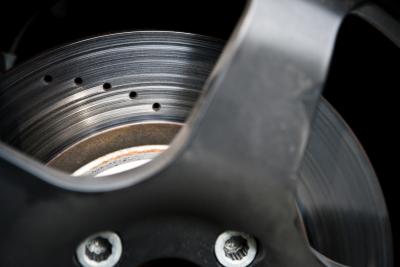
As auto-repair shop prices continue to rise, you may be looking for any way to save money you can. One way to save money is to complete your car maintenance or repairs yourself, including brake pad replacements. While performing a brake job, you may notice that one pad wore down faster than the other did. A small amount of uneven brake pad wear is to be expected, but when there is significant uneven wear, you need to find the source and repair or replace it, or you are simply throwing away your hard-earned money.
On nearly all modern brake systems, the brake caliper rides on two pins that allow the caliper to slide back and forth as needed. To maximize the pin’s effectiveness, the pins must be smooth and well lubricated with disc brake grease. If these pins become dirty, rusty or lack lubrication, the caliper may stick in one spot on the pins. If the caliper sticks with one brake pad or another contacting the rotor, that brake pad will wear out faster than the other, resulting in uneven brake pad wear. To prevent this, always clean the caliper slide pins and apply new grease to them when performing a brake job.
Inside all calipers is a piston that presses the brake pads against the rotor. This piston does not have a retracting feature, a square-cut O-ring retracts the piston just enough to release the brake pads. If this O-ring loses its elasticity, it will not retract the caliper piston, which results in the inner brake pad wearing out faster than the outer. Another cause of uneven wear by failed caliper is if the caliper piston or its cylinder becomes contaminated. This also prevents the piston from retracting and causes the inner brake pad to wear quicker than the outer pad. The best preventative measure for both failures – seal and piston – is to perform regular brake fluid changes. Once a year is how often most professionals recommended flushing the brake system, even if the manufacturer does not include brake fluid flushes in your vehicle’s maintenance schedule.
The brake rotor is supposed to be a level surface, so the pad can grip it firmly with its entire friction surface. Over time, the rotor can develop small grooves in it. When this happens, you must resurface or replace it. Unfortunately, many do-it-yourself mechanics tend to overlook rotors when performing brake jobs and just put on new pads. Due to the rotor’s surface being harder than the friction material on the brake pad, any defects in the rotor transfer to the pad’s friction material, including grooves. You can prevent this type of uneven pad wear by thoroughly inspecting your vehicle’s rotors during each brake job and replacing or resurfacing them, as needed. Not only does this keep pad wear even, but it also improves your vehicle’s stopping distance.
Like any mass-produced automotive component, there is the potential for poor workmanship. Brake pads undergo a series of inspections prior to hitting the parts store shelves, but human and computer errors do occur. If one brake pad’s friction material is less dense than the other – even the slightest amount – you will notice that one pad wears out quicker than the other. There is no way to prevent this, however, most brake pads come with a warranty and you can exchange the defective pads for new ones.